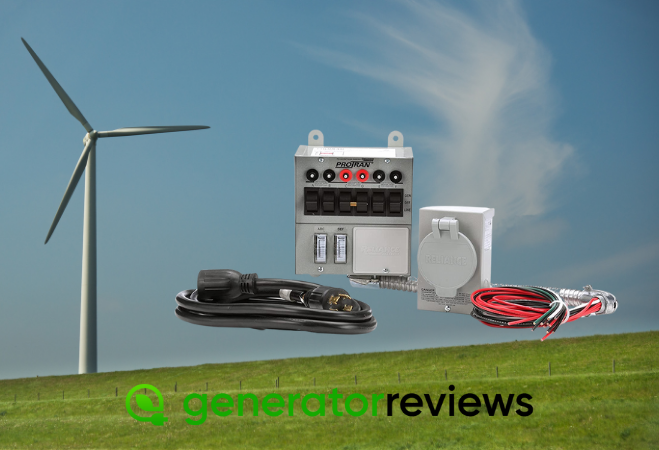 Purchase your generator for the best price at Amazon.com!
Purchase your generator for the best price at Amazon.com!Portable and standby generators can keep you and your family safe and comfortable in the event of a power loss.
When you don't have a generator transfer switch, using a generator might be dangerous and difficult. When the power goes out, you can use a generator transfer switch to convert your home's power source from the grid to the generator.
A manual transfer switch is required for portable generators, however automatic transfer switches are installed in stationary backup generators. There are positives and negatives to each.
Despite the fact that an automatic transfer switch is more expensive, it is more convenient for the homeowner because it is installed by the electrician together with the generator and functions automatically.
However, a manual transfer switch is less expensive than an automatic switch, but it is more cumbersome to switch on and off in the event of an outage.
There are a number of elements to consider when purchasing an automatic or manual generator transfer switch, from the sort of generator you possess to the transfer switch's dimensions.
The electrical needs of your home must also be considered before purchasing a generator or a transfer switch.
When installed by a trained electrician, stationary backup generators are directly connected to the home's circuits. With a stationary backup generator, you get a more reliable and long-lasting supply of energy for your home.
Also included is a generator transfer switch that automatically switches the home's power source from the grid to the generator.
Installation and activation of the transfer switch are no longer a concern during power outages. This added comfort and security is well worth the additional cost for many homes.
The incoming electricity flow from the electrical grid is constantly monitored by an autonomous standby generator transfer switch.
When it detects an interruption in the electrical supply, it quickly alerts the generator to begin. Your home's electrical circuits will be connected to the generator's power source after the transfer switch has been activated. It simply takes a few seconds to complete this process.
Transfer switches cut off power from a generator when they detect a restoration to the usual voltage level of electricity in the utility grid.
It will take a few minutes for the generator's engine to cool down. Transfer switch is ready to convert electricity back to the generator if the next outage occurs. Regardless of what is happening outside the house, this procedure ensures that the residence has a constant source of electricity.
Switching power from the grid to a generator can be done automatically, however manual transfer switches require a homeowner to switch over manually.
Manual power switches are common on portable generators that aren't wired into the house's electrical system. Transfer switches should just take a few minutes to correctly install and only a single extra step to manually switch power on and off.
NEMA ratings determine whether manual power switches should be installed indoors or outside.
The manual transfer switch must be turned on, the generator plugged into the inlet box, and then the portable generator turned on during a power outage. Power should be restored to the residence in a matter of seconds.
The generator must be turned off, unplugged from the input box, and then reconnected after the power has been restored.
You may not be able to power all of your home's electronics with your portable generator and transfer switch. The amount of circuits you can power depends on the generator's output. Most 5,000-watt generators can supply six circuits, whereas larger generators may be able to power ten or more circuits.
Water heating and air conditioning should not be used to preserve energy, the dishwasher and dryer should also be put on hold until the electricity has been restored.
Overloading the transfer switch and the generator are both possible consequences of trying to power too many circuits at once.
Although a manual transfer switch can be used to run electrical devices directly from a portable generator, it is considerably safer and more convenient to have a transfer switch.
Running without a switch necessitates the use of extension cords to connect each electrical item to the generator.
Not only is this tedious and time-consuming, but it may necessitate you leaving open windows or doors, which could put your home at risk.
As a result, homeowners should avoid using portable generators in conjunction with their home's appliances unless absolutely necessary, without a transfer switch.
Using extension cords to connect the generator to your home's electrical appliances will not automatically turn the generator off.
For now, the power will be sent back to the generator. This could result in damage to the generator and any related equipment, as well as a fire or electrocution. With a portable generator, it's best to buy a transfer switch as well.
The size or amperage of a transfer switch will be determined before you purchase and install one. In terms of amperage, the transfer switch can safely or accurately manage the current.
For a transfer switch, you'll likely notice a variety of amp ratings when you begin shopping. Transfer switch capacity is shown by this figure. For example, if the transfer switch has a maximum capacity of 50 amps, its size will be stated as 50 amps.
When sizing your transfer switch, it's important to consider how much power your generator will be putting out.
The largest outlet on your generator should be used for this purpose. A 30-amp transfer switch should be purchased for a generator with a 30-amp outlet in order to get the full power load.
When using a generator and a transfer switch, it is important to avoid overloading the system by providing too much power at once.
Wattage meters incorporated into some power meters allow users to know what their devices are using. As a result, this prevents the generator and appliances from overheating and causing damage.
Aside from deciding if you need a manual or an automatic transfer switch, there are a lot of other considerations to consider.
When it comes to transfer switches, they might be single-circuit, dual-circuit, or multi-circuit. Multiple circuit transfer switches may be needed for larger and more powerful generators; for smaller and less powerful generators you may just need one or two.
It's also worth noting that most transfer switches can be set up either inside or outside the house. NEMA 3R-rated outdoor transfer switches can tolerate a wide range of weather conditions without being damaged.
Pre-wired transfer switches are more expensive but easier to install, while non-pre-wired switches are less expensive but more difficult to install.
In order to properly install an automatic generator transfer switch, a trained electrician should be used. I recommend that you study your owner's manual before installing a manual transfer switch.
I have included a general installation tutorial below. You must obey all applicable safety and code restrictions if you decide to install it yourself.
Switch the primary breaker on your electrical service panel to the off position first. The main breakers will still be energized at the terminals where the power enters.
In the event of a power loss, you'll need to know which circuits in your home are most important for emergency use. There is normally at least one lighting circuit in addition to the refrigerator and freezer.
The circuit inlet on your pre-wired transfer switch should match the circuits in your critical circuits. In the transfer switch, try to distribute the load as evenly as possible: In other words, if your refrigerator is on the leftmost switch circuit, connect your freezer to the circuit on the right.
Knob at the bottom of the primary service panel box should be removed. Consider the size of the connector on the flexible conduit coming from the transfer switch when selecting.
To avoid damaging the insulation, insert the transfer switch's wires into the knockout hole. Each wire in the switch box has a label indicating which circuit it feeds.
Use a locknut and a bushing to secure the flexible conduit from the switch box to the main service panel.
A wall-mounted transfer switch box should be attached to the wall with its closest edge about 18 inches from the center of the main service panel. Depending on the sort of wall you have, you can use different connectors.
Unscrew the hot wire lead from the lug on the first important circuit breaker and remove it from the main service panel box.
Make a note of which switch box circuit has a red wire for the circuit you disconnected. Reinstall the breaker after attaching the red wire to the one you just removed.
Using a yellow wire connector, connect the black wire from the same transfer switch circuit to the old feed wire. The wires should be neatly tucked away at the box's edges. Repeat the technique on the next circuit.
Make sure that all of your vital circuits are protected by connecting the red leads from the transfer switch circuits to the double-pole breaker. Transfer switches should be located adjacent to each other, and the handles of both switches should be tied together.
Connect the white neutral wire from the transfer switch to an opening in the neutral bus bar on the main service panel once all circuit connections have been made.
Connect the transfer switch's green ground wire to an open port on your main service panel's grounding bar. The transfer switch should be installed now that the wiring has been completed. Replace the service panel box cover and complete the switch box circuit map.
Start by making sure that all of the switches on the transfer switch are set to the line setting. The primary power breakers should be shut off.
Ascertain that the backup generator has been fitted correctly.
Switch on the generator by connecting the generator's power cord to the switch box.
As you work your way through the transfer switch box's several circuit switches, flip each one to the GEN position.
That's all there is to it!
It's never too late to call the pros for help if you're still wondering which manual transfer switch is appropriate for your generator and home. Hope you enjoyed the article!

